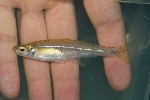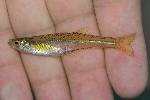
A Biogeographical History of Chirostoma (Pisces: Atherinidae): A Species Flock from the Mexican Plateau
Por Barbour, Clyde D
Copeia, 1973(3):533-556 28-ago.-1973
" The genus Chirostoma is virtually restricted to the Mesa Central, the southern part of the Mexican plateau. The evolution of the 18 species and six subspecies is examined from the standpoint of the major factors underlying their present distribution: the geological history of central México and their trophic relationships as deduced from morphology. An attempt is also made to find evolutionary patterns common to fish species flocks in general.
The Mesa Central has a long history of geological instability. Tectonic movements associated with the Laramide Orogeny, mid-Tertiary and Plio-Pleistocene vulcanism and mid-Pleistocene unlift and associated vulcanism have resulted in continuously changing drainage patterns. During the Tertiary and early Pleistocene, the ancestral Rio Lerma probably flowed westward, perhaps through a series of lakes, to the Pacific Ocean. The exact course and extent of the ancestral system at this time are unknown. Mid-Pleistocene uplift compartmentalized the drainage. At first the river was able to continue a course through the ancestral Chapala basin probably utilizing the present Rios Tuxpan, Ameca and perhaps the Rio Grande de Santiago drainages as exits. Finally, however, uplift blocked the flow and the present outlet to the Rio Grande de Santiago was gained. Lakes, playa lakes, and lacustrine deposits which occur across the Mesa Central are evidence of the size of this late Pleistocene system. Changes in lake levels, presumably reflecting late Pleistocene pluvial periods, are indicated by terraces.
Interior basins formerly part of the Lerma system, as indicated by the distribution of Chirostoma, are the Llanos de Puebla, Puebla-Tlaxcala; the Llanos de Apan, Hidalgo; the Valley of Mexico, Federal District-State of Mexico; Lakes Zirahuén, Pátzcuaro and Cuitzeo, Michoacán; Lakes Atotonilco and San Marcos, Jalisco; Lakes Santa Maria and San Pedro Lagunillas, Nayarit; Lake Juanacatlán, Jalisco and Laguna de Santiaguillo, Durango.
There appear to have been two centers of evolution for the jordani species group: the Chapala basin and the Uruapan-Lakes Pátzcuaro and Zirahuén region of Michoacán. C. humboldtianum has a distribution which probably antedates the uplift, whereas the range of C. jordani more probably reflects the extent of aquatic connections across the Mesa Central late in the Pleistocene. The species of the arge species group have differentiated throughout most of the Lerma basin. The presence of C. arge in the headwaters of the Rio Verde and the Rio de la Laja is suggestive of the route utilized by the ancestor of the arge group during its movement onto the Plateau. C. labarcae and C. aculeatum have complementary distributions reflecting their centers of origin in the Chapala basin and the Bajio, respectively. The ranges of other species are too restricted to show any pattern.
The coexistence of various numbers of species of Chirostoma is clearly facilitated by differences in body length. Prey are probably selected on the basis of size alone rather than kind. The diphyletic nature of the genus is also clearly revealed in the structure of the atherinid communities. The earlier radiating members of the jordani species group have filled most of the large species niches whereas the later evolving arge species occupy either the small species niches in the lacustrine communities or remain allopatric. C. aculeatum occurs in an area which has been free of the larger species for long periods of time. It is the only member of the arge group which has markedly increased in body length, thus demonstrating that character displacement has occurred. Character displacement has also occurred in the Chapala basin; the morphological differentiation of C. consocium consocium and C. c. reseratum is related to the number of coexisting species rather than the time of isolation.
The same responses and interaction governing the evolution and adaptive radiation of Chirostoma seem to have also controlled the evolution of other fish species flocks although a lack of thorough phylogenetic systematic analyses precludes a rigorous discussion "
Idioma: English
Referencia en bibliografía de especies (17)
Barbour, Clyde D. 1973. "A Biogeographical History of Chirostoma (Pisces: Atherinidae): A Species Flock from the Mexican Plateau". Copeia. 1973(3):533-556 (ffm00582) (resumen)



